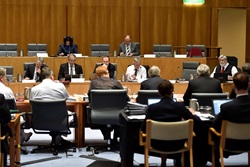
AUSPIC
Posted 24/10/2022 by Stephanie Gill
Observe Senate Estimates (Estimates) and you will quickly become familiar with the phrase ‘on notice’. Up to three times a year the Senate Legislation Committees hold Estimates hearings to examine the particulars of proposed or revised expenditure of departments and agencies. At these hearings senators can question the responsible Minister and senior officials from the departments and agencies. This Flagpost article examines the development of Estimates committees’ questions on notice (QoNs) and what lessons can be learnt as the Estimates hearings commence in the 47th parliament.
On notice in the 1980s
For many years Estimates committees have given advanced notice to departments and agencies on proposed lines of questioning. However this practice led to concerns (pp. 125–6) that information was being merely tabled at meetings—rather than being more fully discussed—and that some senators could use this tactic to avoid meeting attendance altogether. The Senate Procedure Committee (Procedure Committee) subsequently investigated the practice and conversely identified that ‘… it saves time at hearings and allows departments to give considered answers’. Accordingly, the Procedure Committee recommended continuing the status quo, with administration provided through the committee secretariats to standardise the process. This was subsequently enacted as an order of continuing effect on 23 August 1990.
On notice in the 1990s
Given the growing complexity and time taken reviewing government expenditure, in December 1991 the Procedure Committee recommended enacting supplementary hearings of Estimates Committees. This was adopted by an order of continuing effect on 6 May 1993. The Procedure Committee’s report also recommended that answers to QoNs be lodged with the secretariat by an agreed deadline, and new matters be raised prior to the next supplementary hearing. In 1997 the Senate ruled that the notice period for QoNs prior to supplementary Estimates ‘be not less than 3 working days’, based on the Procedure Committee’s recommendation.
On notice in 2022
More recently, the practice of advanced notice seems less of a focus. Contemporary examples include Senator Glenn Sterle on funding to infrastructure projects and former Senator Alex Gallacher who wrote to Treasury regarding housing policy and requesting the tabling of current data. In both examples the senators received an answer on the day of the Estimates hearing, rather than their question being taken on notice.
Witnesses from departments and agencies are required to comply with the Government guidelines for official witnesses before Parliamentary Committees and related matters which states (s4.15):
While it is appropriate to take questions on notice if the information sought is not available or incomplete, officials should not take questions on notice as a way of avoiding further questions during the hearing.
Once taken on notice, the department or agency usually has six calendar weeks to respond. Figure 1 shows the total number of questions taken on notice orally during the hearing and afterwards in writing across all eight Senate Legislation Committees, between 2018–19 and 2021–22, providing a sense of the volume of QoNs and resourcing involved in coordinating them.
Figure 1 Questions taken on notice at Senate Estimates 2018–19 to 2021–22

Source: Senate Estimates - Questions on Notice
*Main Budget Estimates is typically 3 to 4 days of hearings per committee plus one day for cross-portfolio agencies. Supplementary and Additional Estimates is usually 2 days of hearings plus one day for cross-portfolio agencies.
**Main Budget Estimates in 2019–20 was interrupted by the calling of the 2019 federal election.
As a transparency measure, in 2014 the Senate established order of continuing effect 21 Estimates hearings – Unanswered questions on notice. This required the tabling of QoNs statistics (total number taken, provided on time or late) from the previous Estimates hearings by the relevant Minister. Occasionally, where QoNs have been unanswered, this has led to orders for production of documents requiring a more prompt response.
For further information and context, see: